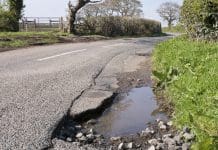Emily See, senior infrastructure asset management consultant at Yotta, explores how local authorities can better plan for highways lifecycles using scenario building methods
The likelihood that the Department for Transport (DfT) will take a more rigorous approach to monitoring and auditing highways lifecycle planning will concentrate the minds of local authority decision-makers. The DfT is looking to ensure that councils are making better decisions for the network and achieving efficiencies and savings as a result. This tougher focus is driven by an acknowledgement that councils are not yet seeing the benefits in terms of financial savings and process efficiencies that they might expect.
Many authorities have been treading water through self-assessment when complying with the requirements of the department’s Highways Maintenance Incentive Fund. Budgetary constraints, political objectives and pressure to fill potholes reactively have made a more strategic view of carriageway and footway maintenance difficult, undermining efforts to build longer-term investment strategies.
Getting the building blocks in place
One of the key challenges councils face in terms of highways lifecycle planning is getting commitment from senior decision-makers across the department and the wider council. Highways lifecycle planning is not easy and requires the investment of significant time and effort. So having the right leadership in place to drive it forward is important.
Authorities also face a range of challenges with the data itself and that’s a major issue given that it is data that drives the lifecycle planning. Approaches to data collection are not always consistent. The staff who do this employ a variety of approaches and are often unaware that their figures then get used much further down the line.
Attaining reliable and accurate data can therefore be difficult, and many councils simply do not use data for lifecycle planning that they perceive to have been collected in an inconsistent manner. Moreover, most authorities use historical data to look at predictive modelling. As a result, it is not just data collected in one year that must be reliable. Councils need to use data to deliver a consistent approach over a number of years
Added to this they often find it challenging to align asset management principles in all departments. This then makes it difficult to collate data from highly separated internal and external sources that have direct bearing on highways maintenance, including routine condition reports and ad-hoc inspections.
Authorities can overcome these problems and plan for the lifecycle of a carriageway or footway, using scenario-building solutions. But before they even start, they first need to ensure that they have good quality data, second that they understand their desired outcomes, and third that they have the skills and the time availability internally to do the modelling.
Rolling out the approach
They can then pull in data from across the organisation and use predictive capabilities to predict performance of the highways infrastructure and present a range of maintenance options over three-to-five years, matching outcomes to levels of investment for each carriageway or footway and different maintenance strategies. They can, for example, scope out the impact of budget cuts on asset performance over time, or assess how much additional money might be needed to keep network performance at its current level. Setting out the scenarios in that way gives councils the intelligence they need to make informed choices.
This gives each organisation a set of defined outcomes unique to its own assets and circumstances. It powers better decision-making, reducing the costs and inefficiencies that inevitably follow short-term, worst-first approaches and helping to make the case for further investment. That might typically involve highlighting the available options to councillors, and asking them to make an informed choice.
Authorities can also use the approach to minimise the cost of maintenance over the asset lifecycle. Ultimately also, highways lifecycle planning allows them to get on the front foot and be more proactive. That in itself will help reduce the problem of potholes, for example. By tackling potholes proactively, councils can reduce the problem and the political focus on reactive filling.
Highways lifecycle planning enables them to push back on the politicians and say, actually, it’s not about potholes. It’s about asset management and lifecycle planning and looking at the bigger picture and the longer-term picture in addition to taking a short-term view.
Highways lifecycle planning is now starting to evolve further to encompass areas like climate change and reducing carbon emissions. Councils are starting to feed this kind of data into their modelling also, in addition to budget and performance. it is an important consideration. After all, today, an option may be more expensive in purely financial terms but still be a viable option because it supports a lower carbon output. Councils will be able to pinpoint what the budget will need to be and what performance levels will be against different levels of carbon output.
There will also be a new question around carbon emissions within the Highways Maintenance Incentive Fund, which will help ensure local authorities are now considering the question of carbon emissions in their highway maintenance activities – and a big part of that will be including it in lifecycle plans.
Again, from the council’s perspective, it is a case of being in a position to model these kinds of scenarios quickly to support the decision-making process.
Where councils are at and where they are going
When the Local Highways Maintenance Incentive Fund was first published, many councils were driven to start looking seriously at lifecycle planning. But even today, there are only a handful of councils that in reality are confidently undertaking this approach to lifecycle planning. Some are doing it more roughly and others are much earlier in the process.
Looking further ahead, having lifecycle planning capabilities also increases the likelihood that authorities will meet the evolving requirements from the Department for Transport, which are likely to be more demanding over time.
We also see great potential for councils to expand the scope of their highways lifecycle planning. At the moment, most councils are really only doing lifecycle planning for footways and carriageways. Over the next five years, we would expect that to change as they first bring areas like structures and street lighting on stream and then even functions like street furniture and drainage where the authorities currently just don’t have the information they need to carry it out.
Going forward, the vision for the industry is to join these functional areas together and carry out lifecycle planning across all assets rather than looking at them as siloed operations. That will be positive news for councils as it will enable them to further expand the benefits they get from lifecycle planning and reap the rewards by building a model that optimises investment and maintenance strategies across their entire highways network.














